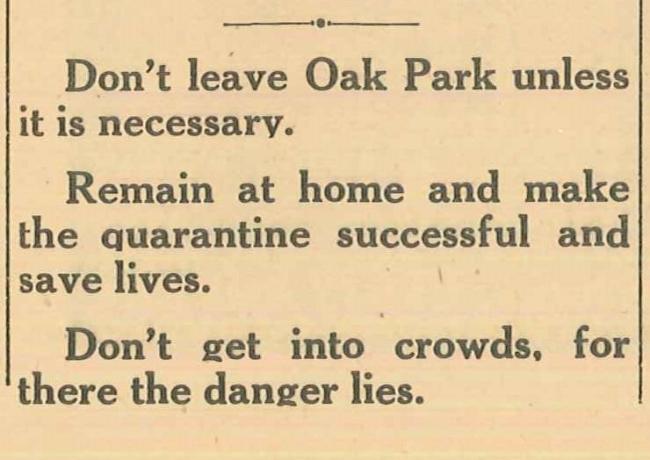In late 1918 as World War I was in its final months, having killed more than 18 million people, an even more deadly event was decimating the globe –the “Spanish Flu” or Influenza Pandemic. From 1918 to 1919 the pandemic killed three to five percent of the world’s population and reduced life expectancy by 12 years. October 1918 was particularly lethal and Oak Park was not spared.
Twenty-three-year-old Charles T. Widman, a sailor at Great Lakes Naval Station, was the first Oak Park victim. He died less than 24 hours after contracting the disease in late September. On October 5, Dr. Frank Needham, Oak Park Commissioner of Health, placed a notice in the Oak Leaves advising residents on prevention and treatment while the influenza was “raging in the north shore suburbs.” He said there were comparatively few cases in Oak Park, although a number of serious cases had been reported to the health department. He advised that with the appearance of cold symptoms such as runny nose, coughing, fever and muscular pain, patients should be isolated and a physician consulted. Those recovering from the disease were advised to avoid public contact until their coughing had stopped.
By October 19, it was clear that the flu had taken a strong hold in Oak Park with 765 cases having been reported in the previous two weeks. Dr. Needham and the Department of Health imposed “swift and radical measures” to stop the epidemic, calling it the deadliest that had ever struck the country. The “swift and radical measures,” which were to be implemented immediately and continued indefinitely, were to close all public and private schools, quarantine all school children in their homes and yards, and prohibit even small gatherings of children. In addition, all churches, theaters and movie houses were shut down; all public meetings and gatherings prohibited; all club entertainments, dancing, dance classes, lodge meetings, public funerals, and social affairs were prohibited, and the reading room of the library was closed.
 By the following week, marked improvement was reported in Oak Park as the number of new cases rapidly decreased due to the quarantine. The quarantine was not lifted and, while it was not ordered, it was strongly recommended that citizens stay away, if possible, from Chicago and especially the Loop, where the flu was particularly virulent. In other news it was reported that a disinfectant had been sprayed on the floors of the elevated trains going into Chicago and that there was only a fraction of the usual train traffic from Oak Park to Chicago. “Oak Park stayed at home and shopped at home and found the experience eminently satisfactory” according to the press.
By the following week, marked improvement was reported in Oak Park as the number of new cases rapidly decreased due to the quarantine. The quarantine was not lifted and, while it was not ordered, it was strongly recommended that citizens stay away, if possible, from Chicago and especially the Loop, where the flu was particularly virulent. In other news it was reported that a disinfectant had been sprayed on the floors of the elevated trains going into Chicago and that there was only a fraction of the usual train traffic from Oak Park to Chicago. “Oak Park stayed at home and shopped at home and found the experience eminently satisfactory” according to the press.
The only event through the popular 19th Century Club was a Red Cross meeting, and while about 20 Oak Park men per week were enlisting in the military for service in Europe, many were delayed indefinitely from moving to their training camps because of the flu. And one Oak Park innovation was reintroduced. First developed in 1907 during a scarlet fever quarantine, a worship aid for in-home Sunday services was developed by the Pastor’s Union, signed by the ministers of most of the Protestant churches in town, and published in the Oak Leaves on Saturday. The Order of Service idea was eventually picked up by other communities where churches were closed due to the epidemic.
By November 9, the quarantine had been lifted for both churches and schools with some restrictions, while all other quarantine measures stayed in place under orders from the village and state health departments. The following week the quarantine was lifted for all but hospitals. Schools were to remain under medical supervision, including the assignment of a graduate nurse (RN) at each school to protect the health of students and teachers. Dr. Needham thanked the community for its cooperation and urged continued vigilance in maintaining proper ventilation in all public and private buildings, quarantining people who appeared to have a cold or flu, and avoiding crowds.
In mid-December villagers were warned there had been a mild recurrence of the influenza but no quarantine or restrictions were required – only the same cautions that villagers stay in town and keep away from crowds.
The epidemic was over and for Oak Park, as well as the entire United States, October 1918 was the deadliest month of the entire pandemic. Worldwide, the influenza killed 30 to 50 million people, with some estimates reaching 100 million. In developed countries mortality was about two percent. In the United States 675,000 Americans died. In Oak Park, due to its diligence, geography, or both, there had been 968 cases, less than three percent of the population, and only 43 deaths, a little more than a tenth of one percent of the village population.
Michael Guerin
October, 2018
Primary Source: Oak Leaves, September 1918 to December 1919
